LED ZEPPELIN THE ONLY WAY TO FLY NEW BOOK/TRAMPLED UNDER FOOT RECORD STORE DAY BLACK FRIDAY SINGLE RELEASE/TBL ARCHIVE – PARIS OLYMPIA 1969/ZEP IN JAPAN 1971 & 1972 – INSIGHTS AND REVIEWS/DL DIARY BLOG UPDATE
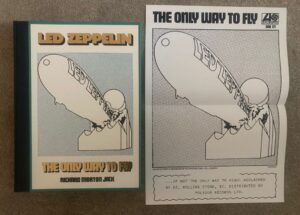
—————————————————————————————————————————————————————
Led Zeppelin Trampled Underfoot single for Black Friday/Record Store Day release…
Led Zeppelin Trampled Underfoot single now confirmed for Record Store Day/Black Friday release on Friday November 28 in a limited run of 6,100.
Here’s the info:
For exclusive release via RSD Black Friday, the single is a 1:1 replica of the 1975 UK 7″ Promo, and presents “Trampled Under Foot” backed with “Black Country Woman”.
Both tracks use the Physical Graffiti 2015 remastered album audio, which was produced by Jimmy Page for the original album reissue 10 years ago. Lacquers were cut at Metropolis Studios in London.
https://www.recordstoreday.co.uk/black-friday/Trampled%20Underfoot
—————————————————————————————————————————————————–
TBL Archive 1:
LED ZEPPELIN AT OLYMPIA PARIS OCTOBER 10, 1969 – IT WAS 56 YEARS AGO – TBL ARCHIVE REVIEW
To mark the 56th anniversary of the Led Zeppelin Olympia Paris gig today, here’s my 2014 review of the companion disc that features Jimmy’s edit of the show.
Led Zeppelin – Led Zeppelin I
The Companion Audio Disc: Live at the Olympia, Paris, October 10th 1969
Good Times Bad Times / Communication Breakdown (4.05)
I Can’t Quit You Baby (6.41)
Heartbreaker (3.49)
Dazed and Confused (15.01)
White Summer / Black Mountain Side (9.19)
You Shook Me (11.55)
Moby Dick (9.21)
How Many More Times (11.14)
The debut Led Zeppelin album was the recorded statement of their first few weeks together. The material selected had been well rehearsed and pre-arranged by the four, one of the primary reasons it took a mere 36 hours to record the album at Olympic Studios, in Barnes, West London.
It’s evident there was very little left over from the album sessions, though back in 1992 Page did salvage Baby Come On Home (aka Tribute To Burt Burns), an outtake from this era that appeared on the Boxed Set 2 compilation. It’s been reported over the years that Zep rehearsed cover versions of The Band’s Chest Fever, Bobby Parker’s Watch Your Step and Elmer Gantry’s Flames but it would appear they were never recorded, as Jimmy has not come up with any alternate versions or outtakes from the first album’s sessions.
Instead he has used the companion disc platform for the first album to present a fully fledged 1969 live on stage recording. There may have been a case for an earlier representation of the band being made available- notably the early Fillmore 1969 appearances (and who knows maybe that situation will be addressed in the future).
However, Jimmy has opted for a later 1969 performance. The source is a radio broadcast of the band’s performance at the Olympia in Paris on October 10th 1969, recorded by Europe 1 radio for the Musicorama programme and part of a short European tour Zep were undertaking during that autumn. A 78 minute edit of the show was first aired on November 2nd 1969. Left to languish in the radio station’s archives for some 38 years, it was re broadcast on December 7th 2007, just three days before the band’s reunion concert at the O2 in London. The recording was subsequently bootlegged, most versions with the French DJ introductions left in and unevenly mixed.
Overall this is a much punchier mix than the bootleg version. To accommodate the formatting , there are some edits and the whole presentation clocks in at just under 70 minutes.
There is no band introduction and much of Robert’s between song chat is edited. As for the actual songs themselves, Good Times Bad Times/Communication Breakdown ,I Can’t Quit You Baby, Dazed And Confused ,White Summer/Black Mountain Side ( missing the ‘wanking dog’ Plant reference !) are relatively uncut from the original broadcast. The previously unheard Moby Dick clocks in at 9.21 – it can assumed that there has been some editing on this as Bonzo’s showpiece of the time was clocking in at around 15 minutes. There’s a slightly unorthodox intro to the piece as Jimmy comes in slightly later with the riff, behind Bonzo’s tympani playing. After the riff comes back in at the end, Bonzo undertakes a final percussive flurry with a boisterous shout and then a 50s riff from Jimmy brings it all to a close.
Heartbreaker is edited to a very compact 3 minutes.49 – during the solo just as the recording goes into that weird echo effect of the radio broadcast. Jimmy avoids that sequence and cuts it straight into the up-tempo solo – it all clocks in at a compact 3 minutes 49.
How Many More Times is scaled down from the 22 minute original performance to 11 minutes 14. There is some chat from Robert prior to the track – it then omits the onstage band member’s introductions during the intro as was custom at the time and cuts straight to the riff.
There’s therefore no room for Aynsley Dunbar reference or the Lemon Song/Boogie Chillun’ sequence featured on the broadcast – however the Oh Rosie/Steal Away (backed by a distinctive Whole Lotta Love riff) and The Hunter is in there – in effect this version is in a similar arrangement to that of its studio counterpart. A final goodbye and namecheck for the players brings proceedings to a close.
The Paris Olympia show vividly demonstrates Led Zeppelin’s progression as a unit during their first year together, in particular the growing confidence of Robert Plant, his shrill vocal attack adds real vitality and spark to the proceedings.
Highlights: The opening Good Times Bad Times/Communication Breakdown salvo with John Bonham doubling up the bass patterns to whip them into shape. The pure blues attack of I Can’t Quite You Baby and You Shook Me – the latter providing a loose framework for a lengthy improvisation –and the How Many More Times finale which carries the listener along on an irresistible adrenalin rush.
After completing another US tour in the fall of 1969, they would go on to revise the act for the opening gigs of 1970. This Paris performance is therefore a welcomed official representation of the band at this point – with a set list still full of Zep I vitality nurtured during the countless gigs they performed that year – and now maturing with the introduction of new material from the about to be released Led Zeppelin II.
This then is an energetic snapshot of the often wild abandonment performances of this era. Whilst the bootlegs serve their purpose, when it comes to the officially sanctioned live album releases (of which How The West Was Won would be a template), I feel there’s a real sense that we are hearing Led Zeppelin as its original founder perceives it. That is reason enough to welcome Led Zeppelin Live at the Olympia 1969 into your homes and onto your deck at the earliest opportunity…
Dave Lewis – May 20th, 2014
———————————————————————————————————————————————————————–
TBL Archive 2:
Here’s some very interesting observations and insights about the two Led Zeppelin tours of Japan written and compiled by long time TBL correspondent Hiroshi…
Led Zeppelin in Japan: a few things not known across the sea (Part 1: 1971)
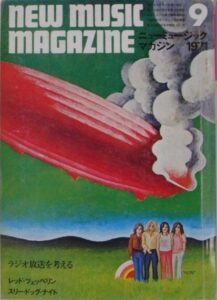
New Music Magazine, September, 1971 issue (out in the shops late August)
“Led Zeppelin are coming” feature. Report on the last minute cancellation and the subsequent resume of the tour.
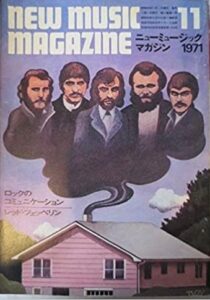
New Music Magazine, November, 1971 issue (out in the shops in late October)
Two articles reporting the Japan tour: “The Airship Troopers Storm Japan” by Ichiro Fukuda — who quotes Robert’s harsh comment on the Berkeley crowd — and “Blown Away By Zeppelin” by Toyo Nakamura, the editor in chief. Both writers attended all of the five shows.
“The prevailing opinion is that Osaka first night was the best show, which I am partial to.” (Nakamura)
Come Autumn, it is the time to reminisce about Led Zeppelin’s two consecutive Japanese visits in 1971 and 1972. Five years ago, I submitted two-part article to TBL (dated 1 and 7 October 2000), which provided the readers with some unknown information outside Japan. They have never since been republished here. I have updated it with some tweaks and corrections, amending factual errors and adding some new information. Hope you enjoy these pieces and get some enlightenment from my writing.
Led Zeppelin’s Japan tour in 1971 was one of their most memorable and full of incident. Such happenings and tales, fascinating as they are, have not been fully reported abroad due to the language barrier. Here is an attempt to get across some of them for the convenience of the overseas readers. For this purpose, the photo book, Live Tour In Japan 1971 & 1972 (Shinko Music, 2019), served as a great source of information, among others. I would like to thank all who are concerned.
As is often the case with all things Zeppelin, Ahmet Ertegun played a big roll in materializing the group’s tour of Japan. When Warner Pioneer Inc. was founded (dated November 11, 1970), the distributorship of Led Zeppelin records in Japan was transferred from Nippon Gramophone to them. Ertegun flew over to Japan to attend the press conference for the company promotion, where he declared he would make Zeppelin’s Japan tour happen. It did.
The concert tickets were to be released on August 5. However, in the evening of the day before, the 4th, the news of the tour’s cancellation at the last minute was aired over the radio out of the blue, which gutted the fans. The story goes that due to John Paul Jones’ sudden illness, the U.S. tour that preceded the Japan dates would have to be entirely rescheduled, and the promoters, Kyodo Tokyo, came to the conclusion that the tour had better be withdrawn as quickly as possible to avoid the predictable mess. Kyodo office was flooded with protesting phone calls from the distraught fans the next day. The promoters started a further negotiation with Ertegun by international call, and at the end of the day, both sides agreed to give the go-ahead for the tour as initially planned — a little drama was unfolded below the surface until the matters settled. The tickets finally went on sale on the 9th. Today, this whole scenario sounds rather dubious as there are no such records as the said rescheduling of the U.S. tour left anywhere. The true reason aside, had the tour had actually been cancelled, there is a fair possibility that it would have been tacked onto the Australia/New Zealand tour 1972, and the group’s legendary Japanese saga would have surfaced as a whole different story from what it was.
For their 1971 visit, Led Zeppelin were initially scheduled to arrive in Japan in the afternoon of Tuesday September 21. They then informed the promoters in Japan that they changed the plan and would arrive on the 20th. As it turned out, Page, Bonham, Grant, Cole and Carson flew out from Hawaii on Saturday 18th, the day immediately after finishing the two shows in Honolulu 16-17, and landed at Tokyo Haneda Airport at 15:25 on Sunday 19th. Next day, they turned up unexpectedly at the Warner Pioneer office in Roppongi in the morning without notice, taking the record company staff by surprise.
After spending another couple days for the rest and vacation in Hawaii, Plant and Jones flew in to Haneda Airport later than the other group, in the evening of Tuesday 21st, to be greeted by the rest of the team who had already entered Japan. Outside the arrival gate, Bonham was seen holding an Akai video recorder in his hand, apparently for professional use, that he had purchased in the afternoon. The cumbersome video tape deck hung from his shoulder weighed approximately 10 kg! He was caught in the pics from the later dates carrying a more common Super 8mm camera that was handier to use.
Mr. Setsuo Yamada (b. 1898 – d. 1975), the mayor of Hiroshima-city at the time, after graduating Tokyo University, studied at Oxford Uni in the pre-WW2 times thus spoke fluent English. In his office, he talked to the members of Zeppelin without an interpreter, which must have impressed them. He also attended the group’s show that night, only to leave the seat after a short while, due to the ear-shattering volume…or so the story goes.
The anecdote Richard Cole described in his Zeppelin bio, Stairway To Heaven — “about four minutes into the song, he [Carson] suddenly realized that his bass was the only instrument he was hearing. He quickly looked around – and he was alone on the stage. As a prank, the band had snuck off in the middle of the song, leaving Phil to fend for himself. He made a valiant attempt at a bass solo, but he gave up once it was clear that the guys weren’t going to rescue him. Phil put down his instrument and ran off the stage, too, as the band rollicked in laughter.”
No such act of ridicule happened. Sure, Atlantic executive Phil Carson played the bass instead of Jones, and roady Clive Coulson joined the chorus, on C’mon Everybody for Osaka first night’s encore. As you hear on the bootleg source, Led Zeppelin played through the song without pause. And finishing the performance, Plant introduced both people, calling out their names proudly. Wrong remembrance or pure make-up by Cole.
It is mentioned in November 1971 issue of the Music Life magazine that Japanese guitarist Shigeru Narumo gave Page a custom-made electric guitar [Greco product] as a present and he used it at the Osaka show. It is unclear which date and what song(s) he played with it, but the educated guess among the enthusiasts is that Rock And Roll, the final encore number on September 29, might be it.
After all these years, I observe from time to time a debate among the fans outside Japan whether not only the Osaka shows but also the Tokyo shows were properly recorded or not. They were. In Japan, nobody doubts it one bit from back in the day. In November 1971 issue of the New Music Magazine, it is reported that “both two Tokyo and two Osaka dates were recorded in 8 tracks and Page took back the tapes.” It is argued in some quarters that the shows were recorded in 6 tracks, but the staff member from Warner Pioneer who was in charge of the live recordings mentioned in the article published in January 2013 issue of the Crossbeat magazine that they used a combination of two 8-track, 2-inch reel-to-reel tape decks for the task. In the same article, he also revealed that he diverted the signals via split cables to make a separate recording of the final show (September 29) as the record company wanted to keep it for posterity.
The tapes were then kept and looked after in the storage of Apollon, the company that manufactured music tapes exclusively (including Warner Pioneer catalogues), and someone copied and leaked them, which eventually became the source of the famous bootleg, Live In Japan (also known as Live In Japan 1971). The first-press double LP of the lower-pitched version was out towards the end of 1974, available at only two collectors record shops in Tokyo and Osaka, one in each location, that mainly dealt in import records (I heard from the owner of the Osaka retailer then that around 200 copies were pressed. I bought one in ¥7,000 in March 1975). Part of it was copied later and released as a single LP under the title, A Cellarful Of Noise, from The Amazing Kornyfone Label (TAKRL). Then sometime in 1976, the pitch-corrected 2LP version was recut by the original bootlegger and sold at the same outlets as above. Numerous subsequent versions followed thereafter.
Zeppelin and UFO landed in Japan:
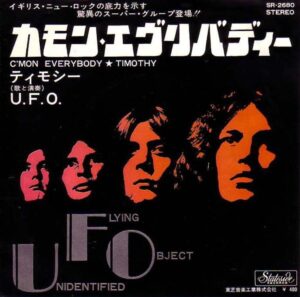
UFO Japanese single: C’mon Everybody b/w Timothy
Release date: December 21, 1970
Oricon chart: 34 (highest)
A little but significant event worthwhile to note is that UFO visited Japan almost simultaneously with Led Zeppelin. They arrived on September 18. After playing at Mugen, the then fashionable discotheque in Akasaka area in Tokyo, for a few nights including the 21st (other dates unclear), they played in Osaka on the 24th and concluded the tour back in Tokyo on the 25th. The final show was recorded and released under the title, U.F.O. Landed Japan (AKA UFO Live/UFO Live in Japan/UFO Lands in Tokyo), initially a Japan-only release.
At night, the members of Zeppelin and UFO mixed with each other from time to time at Byblos, another prestigious discotheque in Akasaka. UFO attended Zeppelin’s press conference for the media that was held at Hotel Hilton Tokyo in the afternoon of the 22nd, where Phill Mogg & Co. were seen asking the bigger stars for autographs! It is said that UFO also attended one of Zep’s Budokan shows (more likely the 23rd as they moved to and played in Osaka on the 24th). Their single, C’mon Everybody, cut from the debut album, had become quite a hit in this country towards the end of 1970, which made UFO ‘big in Japan’, so to speak.
To this day, C’mon Everybody is generally recognized as a UFO song among the Japanese rather than the Eddie Cochran classic (as is Summertime Blues The Who song). It is probable the socializing with UFO motivated Zeppelin to pick C’mon Everybody for the encore in Osaka, September 28. Most likely, a number of people in the audience didn’t know the song was written by Eddie Cochran — they must have thought, “Zeppelin covered UFO!”
Hiroshi
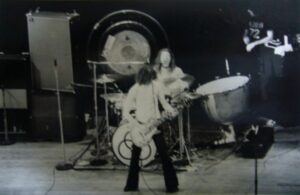
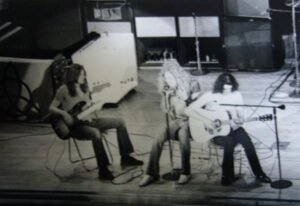
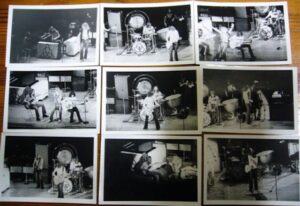
Above – rare images of the Nagoya show, October 5 (photographer unknown)
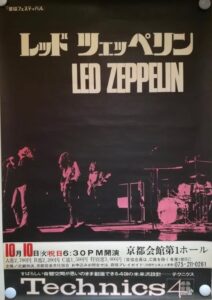
The infamous Kyoto show poster offered for the auction
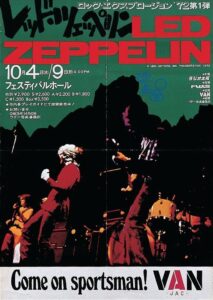
Osaka 1972 poster
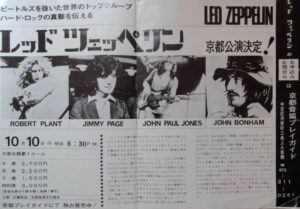
Kyoto 1972 flyer
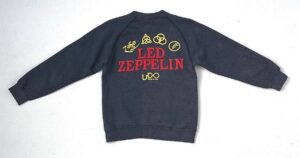
Sweatshirt for 1972 tour staff provided by Udo Artists Inc.
Led Zeppelin in Japan: a few things not known across the sea (Part 2: 1972)
Led Zeppelin and their entourage landed at Tokyo Haneda Airport at 11:51 on Friday September 29, exactly one year after the legendary show in Osaka that finished one of their greatest ever and most historic tours the last year. The cars they hired, however, did not go to the hotel straight away. First they headed for the adjacent Kawasaki-city where they would have a rest at a “special bathhouse”. Best not go further and leave it at that before my writing traces the Hammer Of The Gods version 2.0 route… It was almost near the evening, around five o’clock, that they finally checked in at Hotel Hilton Tokyo.
It is often said that, on their second visit to Japan in 1972, they were banned from Hilton Tokyo because of the antics and the damage they did there in 1971. That is a myth. For all the troubles they made the previous time, they were somehow admitted to stay at the same hotel again. However, the Royal Hotel in Osaka where they had stayed in 1971 indeed refused them in 1972. They instead stayed at the Grand Hotel, which was conveniently situated in the same building that housed the Festival Hall where they played both times.
Like last year, a press conference was held in a large meeting room at the hotel on September 30. To the reporters who gathered, they announced that about 30 to 40 percent of the show contents would be new songs from the forthcoming album. Asked about the then thriving glam rock, the members shunned T Rex, stating that what Bolan was doing wouldn’t last long. As for Bowie, they appreciated that his work had certain substance.
On the 3rd, the day after the opening Budokan show, Page gave an interview to the Music Life magazine in his hotel room. Coming out of the Japanese style bedroom where he had slept in the futon spread on the tatami on the floor, he answered numerous questions. In relation to the question regarding musicians’ involvement with politics, Page replied, “Of course, I respect Lennon, but I think he has been less and less like him since Yoko came along. It feels like he has lost his identity… I’m afraid I may be rude to say this, for I know Yoko is Japanese… I can’t take what she does seriously.” A stark contrast of the view from the unsparing appreciation for John and Yoko by Plant, ever a hippie at heart.
This is the first time Bonham added a tympani to his kit. According to a now retired executive of Udo Artists Inc. who were the promoters for the 1972 tour, it was rented in Japan, not the group’s belongings. Indeed, the b&w photo of the Nagoya show (up on here) captures a bigger and different unit from the one he used on later periods.
The week prior to Led Zeppelin, the James Gang toured Japan (September 22-27, 5 shows in Tokyo and Osaka). Zep requested the Gang to leave their PA system in Japan in advance, and borrowed the gear for the concerts, presumably to economize the cost for carrying equipment.
The venues the Gang played are all theatre-sized, cap 1,500-3,000. Thus, it is safe to assume the PA system was suitable for that purpose. It is often pointed out that the guitar tone of Zep’s 1972 Japan tour captured on the audience tapes is cleaner, thinner and less meaty than 1971, which may have been related to such condition. Interestingly, someone who was there reported that the volume level was higher, the sound louder than 1971. Was it to cover up the inadequate equipment? Food for thoughts for gearheads.
[N.B. Zep using the Gang’s gear is what the record company’s manager who was in charge of the James Gang told on the radio program back in time. Actually the Gang toured North America in early October that coincided with Led Zeppelin’s Japanese dates. If the story was true, a possible explanation would be that the Gang had multiple PA systems and brought one of them to Japan. In any case, I put the alleged tale to spark readrers’ interest and leave it as that.]
The tickets for Led Zeppelin’s second Japan tour that also turned out to be their last, were released on September 1. Contrary to the myth, it was not a sell-out affair. From various sources, e.g. reviews and first-hand accounts back in time, one gets the impression that the venues were not 100 percent full. Tickets were available from the box office on show day, even at Osaka’s Festival Hall that was a 3,000 seater, let alone the sizable Budokan with a capacity of 10,000-plus. The relatively short length of time between the ticket release and the concerts may have resulted in some lagging of the ticket sale.
The reviews were not favorable, either. There were voices of strong criticism and complaints heard from lots of people, fans and critics alike, especially those who had attended the show the previous year. They said it was way below the 1971 show in almost every aspect — the setlist, the show-length, the performance, the energy, just about everything. It was like a whole lotta backlash going on. And above all else, many pointed out the significant decline of Plant’s voice that was very noticeable and often painful to hear.
The inspired Osaka second night, the October 9 show, almost saved the day with their spirited performance. But when the group played a truncated set on the next and tour’s final night in Kyoto, allegedly to catch the last bullet train (departure time: 20:49) that would get them back to Tokyo, where they spent the last night in Japan partying all night at Byblos, things went pear-shaped. The group took the stage at 18:30 prompt, and once they finished the show that barely lasted over 90 minutes and the house lights were on, all hell broke loose. Shouts of anger filled the hall, and there was a near riot happening on the floor. Some rushing to the staff to complain, others climbing up on the stage, voicing their protest aloud. It was reported that someone set fire to a flyer and threw it in the bin! Rock ‘n’ roll, eh? Sadly, this is the scene unfolded right after Led Zeppelin’s last ever public appearance in Japan. Little did we know they would not set foot on our soil ever after.
On May 21, 2018, the rare poster for Led Zeppelin’s Kyoto show was offered at Japan’s Yahoo Auction. One week later, it fetched the final bid price: ¥248,300 (appx. exchange rate at the time: £1,800 ). Some artifact, really.
Now, I wrap up this two-part series with a bitter tale of mine.
In the fall of 1979, when I was a young man, an elder rock fan I knew then — he saw all of Zep’s Osaka shows 71 and 72 but the first night 71, as well as Hiroshima 71 — informed me that he decided to part with his collection of hundreds of records. He generously offered me anything I wanted for reasonable price.
I picked couple dozens. As a bonus, he added a large-sized black and white poster of Zep’s acoustic set in Japan 1971, manufactured by Warner Pioneer, for free. A nice gesture and I was pleased with it.
“By the way,” he then continued, “I have a copy of the poster of their Kyoto show. If you want it, I’ll give it to you, too.”
“What does it look like?” I asked.
“Nothing special. Just a common group shot you see everywhere,” he answered.
“Hmm…I’ll pass it then.”
Don’t ask me why I said that. Later in my life, every time I remember the conversation, I cringe in deep regret. The news of the auction in recent years only rubbed salt into the wounds. Oh well, never mind…life goes on.
Appendix: The aborted Budokan shows 1979
Led Zeppelin’s planned third Japan tour December 1975, which was cancelled due to Plant’s traffic accident, is well-known. But the story doesn’t end there.
A couple years ago, on a Japanese Zep bulletin board, a fan posted his eye-opening find. He visited a local library and checked the old newspapers to unearth Zep-related articles. Among them, Yomiuri Shimbun, the biggest newspaper in the country, 3 January 1980 Evening Edition, had this article, ‘Fussing about foreign acts: What about Led Zeppelin? What about Kiss?’
“While Zeppelin reigns supreme in rock popularity, their Japan tour last October was actually tentatively confirmed. Just before their summer appearance at the UK’s Knebworth Festival, word came that they’d be coming in the autumn. [Promoter] Udo Artists Inc. even reserved the Nippon Budokan for five days, only for the “visit cancelled” notice to turn it into a mere fantasy. The reason, it seems, was that their latest LP, In Through The Out Door, was receiving such favourable reviews that the need for the tour’s primary purpose – record promotion – had vanished.
Rich groups really are different, but Udo, left high and dry by a single notification, were utterly gutted. So what about this year? ‘We are proceeding with preparations, determined to bring them to Japan,’ says Masanori Shimizu, Head of Booking at Udo Artists Inc. However, ‘it depends on the other party,’ so the chances are fifty-fifty. ‘If they come, it would be September or October. That means advance tickets would go on sale in early summer. The Tokyo shows would likely be six or seven at the Nippon Budokan,’ he adds. Well, it certainly keeps one on tenterhooks.”
This is most likely the first revelation of the group’s post-Knebworth activity that got called off eventually. You know the rest of the history…
Hiroshi
Many thanks to Hiroshi for adding fresh insights to the 1971 and 1972 Zep Japanese touring periods.
——————————————————————————————————————————————————-
More Japan 1971…
Last week marked the 54th anniversary of one of the all time great Led Zeppelin live performances – the September 29 concert in Osaka.
Here’s my review of the 2020 Transatlantic Records bootleg release More Comedy Less Work…
Now this is what I call an inspiration…
My thoughts on…
Led Zeppelin- More Comedy – Less Work: Live At The Festival Hall Osaka Japan September 29,1971
4 CD long box package Transatlantic Records
I’ve come a little late to the party when it comes to the recent soundboard tapes that have surfaced from Led Zeppelin’s tour of Japan in 1971. I recently acquired the Please Please Me 6 CD set via the Eelgrass label and I am looking forward to wading through this expansive set of recordings of their September 28, 1971 performance at the Festival Hall in Osaka.
The following night, the last of the Japanese tour has appeared on a variety of releases, most recently as 929 How The East Was Won – this I have on a double CD set, again via Eelgrass that presents the soundboard source.
Now there’s a much longer presentation of this celebrated performance under the title More Comedy Less Work.
It presents the near complete performance with a mix of the aforementioned soundboard source plus the so called multi-track stage recording and a couple of extracts from the September 28th show. All this has been achieved via a Winston tape overhaul. For those who are unaware, Winston is an avid fan who is highly skilled at improving the sound of Zep bootleg recordings. Over the years Winston has widely and freely shared his remastered recordings, many of which have been acclaimed as definitive versions.
With that prospect in mind I could not resist the opportunity to delve into this new version.
I am of course looking forward to soaking up the previously mentioned 6CD Please Please Me set that chronicles the previous night ( I will report back on that one in due course), but my eagerness to hear a complete September 29 Osaka presentation had me ripping off the outer cellophane ready to get intimate with the three CDs. Note a fourth CD in the package showcases an Up Close radio show from 1992 and a Jimmy Page interview from 2017.
The reasons for my enthusiasm are simple:
For a start, all self-respecting Led Zep fans know that the three city, five show Japanese tour the band undertook in September 1971 was very special. Across those gigs they varied the set list considerably, throwing in all sorts of one offs and unique cover versions. The night of September 29 was no exception, in fact being the final night they really went to town.
The basic set list is also pretty much as it was a mere 53 days on from this memorable Osaka 1971 performance when on the night of Sunday November 21, I was lucky enough to witness Led Zeppelin live for the first time on a night of pure electric magic at the Empire Pool Wembley.
During this period Led Zeppelin were right on top of their game – and then some…
These were the nights where they sought as Jimmy would put it, that fifth element. There’s a hunger and vitality in the playing – a sense of wonderment at what they could achieve and how far they could push the boundaries. There was nothing they could not attain musically, their ambitions were infinite.
Other factors: Robert Plant’s vocal register was at its highest and most potent – a quite remarkable instrument in itself that he deployed to maximum effect.
The interplay between Jimmy Page, John Paul Jones and John Bonham was at a new peak of creativity..
They had a brand new fourth album in the can and ready for imminent release and they knew it was good – and of course they were more than eager to preview material from it.
In short, their confidence was absolutely sky high and boy did it show…
Now my relationship between Led Zeppelin and this Japanese tour goes way back. In 1976 I first got to hear what it sounded like via a bootleg LP.
Led Zeppelin A Cellarfull Of Noise – Live In Japan was a single LP on the Kornyfone label. I purchased it from the Sounds Ahead record shop in Marlborough Court just off Carnaby Street – a tiny record shop that specialised in under the counter releases.
Unfortunately this recording of the fabled September 29 Osaka show was strictly lo-fi and it also played slightly slow. It did however open my ears for the first time to the potency of their playing and also included that bizarre interlude when John Bonham went missing. ‘’Where’s Bonzo?’’ proclaimed Robert repeatedly prior to a drummer-less performance of Tangerine.
Things did improve considerably with the acquisition of the various September 29 audience sourced CD set that surfaced in the 1990s. Last year came the much welcomed new double CD of soundboard highlights. It’s always been one of my all-time fave Zep gigs.
Now the oddly titled More Comedy Less Work presents the full show in genuine Winston style.
The packaging itself is fairly rudimentary – a cartoonish illustration with an overhead airship on the front of the digipack long box. The Led Zeppelin script is lifted from the Led Zeppelin III cover and a sticker indication noting that this is a limited run of 300 portrays the group image featured on the back of that album sleeve. The back cover has some brief explanatory notes about how the recording was pieced together. An eight page booklet has small photos from the tour and reproduces the 1971 Japanese tour programme, though in very small black and white thumbnail type pics.
Some further explanatory notes about the unique content of the set list would have been an asset. It’s all in the Evenings With Led Zeppelin book and TBL issue 31 thanks to Mike Tremaglio’s diligent chronicling.
As for the music, well, let them take you there ….to the Festival Hall in Osaka for the final night of what had been a highly successful tour.
I am well versed with this performance via the previous recordings but hearing it complete in such quality is an absolute revelation.
Right from the moment you hear Bonzo exclaim ‘’Louder, louder’ the listener is hurtled right into the action and let me put it on record from the off: This performance of Immigrant Song may well be the best ever – Plant’s echoed shrill is a pure joy, Bonzo pushes it all ahead in tandem with JPJ and as for Jimmy… the moment he opens up the wah wah for a truly scintillating run is one of the all-time great Zep live moments. The unrelenting energy of it all is just extraordinary.
From there, well it’s a total tour de force. Everything that is great about the band – everything that they have learned to harness in a mere three years is all here. The matchless confident stomp of Heartbreaker really hits the mark – as does the slow burn blues rock of Since I’ve Been Loving You. The seamless patch in of Black Dog from the 28th keeps the momentum flowing.
Dazed And Confused is a cavalcade of electric magic – there’s no other words to describe it, and there’s a drop in for a one off extract of Pennies From Heaven. It’s worth noting here that whenever Zep extended the studio versions of their catalogue, as they did many times – it always came out sounding like a development rather than an indulgence – and there’s no finer example of that than this marathon performance.
Stairway To Heaven is a suitable regal delivery and Celebration Day is always great to hear from this era – actually whenever I hear it I am always reminded of the opening sequence at Knebworthon August 4, 1979 when it made a welcome return to the set.
The acoustic set offers blissful light and shade acoustic harmony moving through That’s The Way and Going To California followed by that aforementioned amusing interlude where Bonzo goes missing prior to a sweet Tangerine. What follows is a rare piece of Zep concert history: the only known live delivery of the Led Zeppelin III staple Friends –which is followed by an ad hoc short cover version of Smoke Gets In Your Eyes.
A strident What is And What Should Never Be ushers in a complete Moby Dick – the master Bonham and his art..
The Whole Lotta Love medley is a 31 minute veritable Zep Spotify playlist. Try this for a starters: Elvis Presley’s I Gotta Know segued into Twist And Shout performed as The Beatles used to, followed by Benny Spellman’s Fortune Teller. Again via Mike Tremaglio’s research in the Evenings With book we know this trio are ‘one and only’ recordings, save for a 40-second snippet of Fortune Teller which was (also played in Oakland on September 2, 1970 concert. As they had done during the first show in Tokyo, the band also throw in the rarely played live Good Times Bad Times and a blues wailing You Shook Me.
Finally, after an emotionally draining Thank You this three hour show concludes with Rock And Roll – another preview from their upcoming fourth album and a first time outing on this Japanese tour.
The September 29 Black Dog is added on in the multi-track version.
To summarise:
So what we have here is a near complete representation in the best sound quality yet of one of the truly great evenings with Led Zeppelin.
I’ve been playing non-stop this past few days -and what a much needed inspiration it’s been..
Whilst Led Zep and related artists are never far too away from the player here, this is the first real genuine new Led Zep aural experience I’ve soaked up in a good while. It’s a recording that offers a stark reminder of why I have invested so much time and energy into chronicling this band these past 50 years – and why Mike and I spent a sizable amount of our waking hours over a five year period producing the 576 pages that made up the Evenings With book. It’s one of those times when the power of music – and there’s no finer music than Led Zeppelin at full throttle live in concert in my book – gets right to the soul and provides such inspiration, and as we all know, in these unprecedented times any inspiration right now is much welcomed…
More Comedy Less Work will rightfully take its place alongside the Fillmore West April 27, 1969 performance , Plays Pure Blues (Texas International Pop Festival August 31, 1969), Live On Blueberry Hill (LA Forum September 4, 1970) and Going To California (Berkeley September 14, 1971) as my go-to fix when it comes to the in- concert appreciation of the first three years of Led Zeppelin’s existence.
In a world of current confusion one thing certainly remains ever constant – listening to Led Zeppelin perform live in 1971 is a truly wonderful thing… and this overwhelming September 29 performance of that year is more than ample proof…
Dave Lewis – May 25, 2020
Here’s TBL bootleg expert Paul Sheppard’s views:.
More on More Comedy Less Work – TBL contributor and Zep Live on CD expert Paul Sheppard’s observations:
Led Zeppelin – More Comedy, Less Work
Osaka, September 29 , 1971
Background and Context
There are, to the best of my knowledge, 2 main audience sources plus two soundboard sources for this show. These can be sub-divided into several generations for each audience source plus two generations for the soundboard sources. Over the years, in the realm of Cd bootlegs, we have had copious releases of varying quality using one or the other source or mixes of both.
What it comes down to are the following groupings for the Cd releases that have emerged:
- An actual soundboard – a maximum length of about 90 minutes with Empress Valley feeding out individual track releases as well
- An actual soundboard mix – in reality a mix of audience sources
- Source 1 “soundboard – possibly two different versions and short of the whole show
- Sources 2 &3
- Sources 4 & 5
- Mixes – where most of the show is available and where ‘More Comedy – Less Work’ fits in
More Comedy – Less Work (LZ/TAR) 4 Cd
What we get:
CD1
01 – Welcome To Osaka 929 [aud]
02 – Immigrant Song [sbd] 929 + 928 wail fix edit
03 – Heartbreaker [sbd] 929
04 – Since I’ve Been Loving You [sbd] 929
05 – Black Dog [sbd] 928
06 – Dazed and Confused [sbd] 929 patched
CD2
01 – Stairway to Heaven [sbd] 929
02 – Celebration Day [MT] 929
03 – That’s The Way [MT] 929
04 – Going To California [MT] 929
05 – Tangerine [MT] 929
06 – Friends [sbd] 929
07 – Smoke Gets in Your Eyes [sbd] 929
08 – What Is and What Should Never Be [sbd] 929
09 – Moby Dick [sbd] 929 patched edit
CD3
01 – Whole Lotta Love [MT] 929 +patched audio
02 – Communication Breakdown [sbd] 929
03 – Organ Solo [MT] 929
04 – Thank You [MT] 929
05 – Rock and Roll [MT] 929 – Bonus track
sbd – soundboard (speed corrected -2%)
MT – multi track stage recording (edited to completion with Plantations and various patches by Winston)
As described in the accompanying notes:
This is a merge of the newly released soundboard, previously released stray soundboards and the excellent remaster done by Winston.
Besides the speed correction on the SB portion there are a few small fixes to clean up some very minor sloppiness in the performance. Moby Dick is not quite complete but about 90% there. Black Dog is from the 28th (for the SB).
SB levels were brought down in order to level match and for headroom. Very minor eq and limiting was applied and only in spots to get more cohesion in sound.
The Verdict:
A clean and relatively uncluttered recording with Tarantura influenced packaging (though by no means as luxurious as Tarantura’s). The ‘soundboard’ parts are especially good. Owning as I do, 15 versions of this show either on Cd or stored, I can say that this is as good as it gets and highly recommended. Ok, so we have to accept the inclusions from the night before (notably ‘Black Dog’) but I can live with that. Always a pleasure too to hear the ‘Pennies from Heaven’ segment within ‘Dazed’ which a lot of other releases miss out.
The fourth CD contains eight tracks from a US radio show broadcast on 28th Jul, 1992 called ‘Up Close’ which focuses on the 1990 Remasters alongside an interview with Jimmy Page in 2017.
Paul Sheppard
Many thanks to Paul
DL Diary Blog Update:
Thursday October 3:
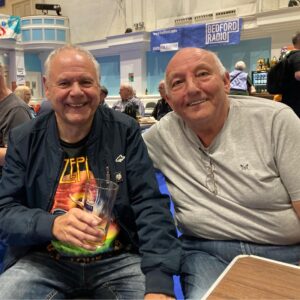
Great to meet up with my cousin Mr. John London for our annual visit to the Bedford Beer and Cider Festival yesterday afternoon…
Friday October 3:
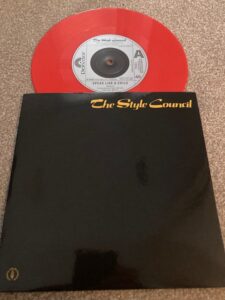
Friday October 3:
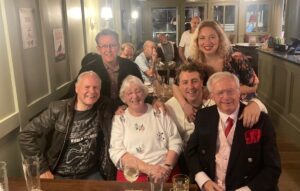
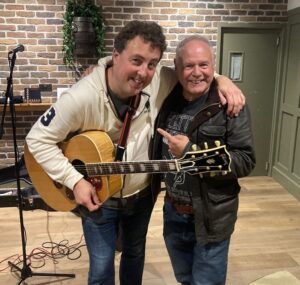
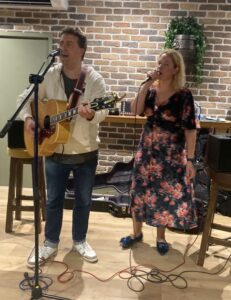
Saturday October 4:
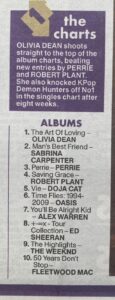
The Robert Plant Saving Grace album made a very credible new entry at number four on this weeks UK official album chart – a mere two places behind the number two entry of his debut solo album Pictures at Eleven in 1982 – on that occasion he was held off the top spot by the ABC album Lexicon of Love. I have to say I have no idea who Olivia Dean is which is this week’s number one – that one is not on my radar but Robert Plant Saving Grace with Suzi Dian certainly is!
Saturday October 4:
Paid a visit to the excellent Morgan Howell shop in St. Albans today. Morgan paints super size replica art works of 45 rpm singles. They are absolutely stunning in detail – the original of the Zep Whole Lotta Love US single seen here is very expensive at over ten grand – however I may invest in the much smaller print version at some point – the shop is well worth a visit if you are in the area
Saturday October 5:
Marking the release of the first Beatles single Love Me Do all of 62 years ago today with a spin of the Please Please Me album…
Sunday October 5:
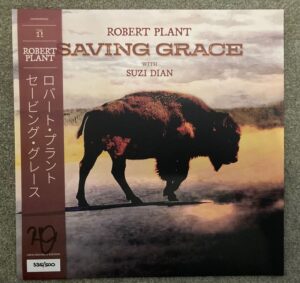
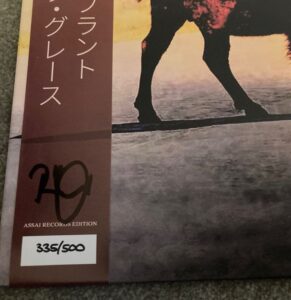
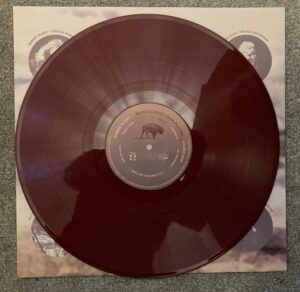
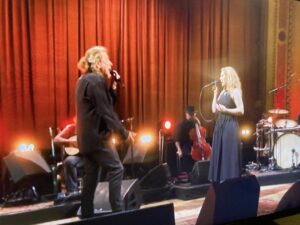
Robert Plant & Saving Grace with Suzi Dian on Later with Jools Holland performing Everybody’s Song …rather brilliant…
Watch it here:
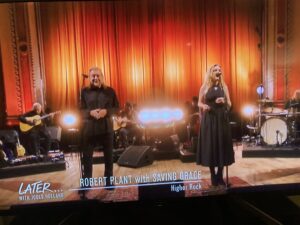
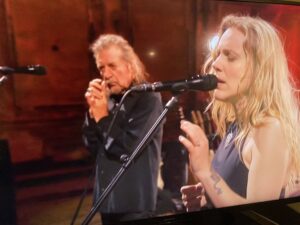
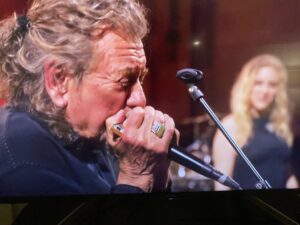
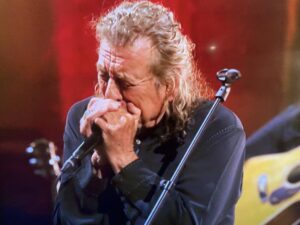
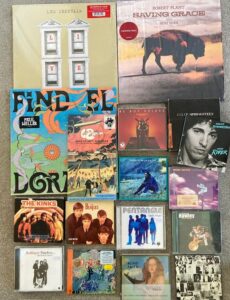
Sorting out some LPs and CDs for the DL playlist autumn playlist – here’s the line up so far…
Robert Plant -Saving Grace with Suzi Dian – LP
Led Zeppelin live EP – 12 inch single
Led Zeppelin – More Comedy Less Work Osaka Sept 29 1971 4 CD
The Rolling Stones – Exile On Main Street -CD
Paul Weller – Find El Dorado – LP
Bruce Springsteen – The River -CD
Moby Grape – Vintage The Very Best Of – 2CD
The Beatles – Love Me Do – CD single
The Zombies – Odessey and Oracle – newly remastered in mono CD
Terry Reid – Other Side of The River – CD
The Kinks – Are The Village Green Preservation Society – 3CD
Blind Faith – Blind Faith – 2 CD deluxe edition
Badfinger – Timeless – The Musical Legacy – CD
Be Bop Deluxe – Futuristic Manifesto 1974 – 1978 – 5CD
Pentangle – Anthology – 2CD
Richard Hawley – Lady’s Bridge -CD
Until next time…
Dave Lewis – October 8 2025
TBL website updates written and compiled by Dave Lewis
Follow TBL/DL on Facebook:





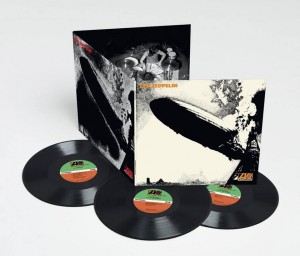
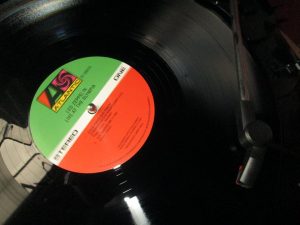
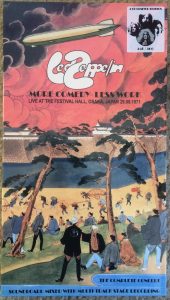
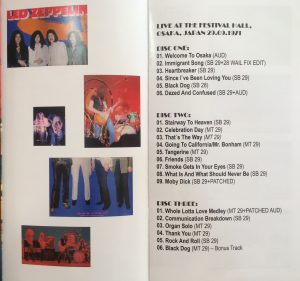
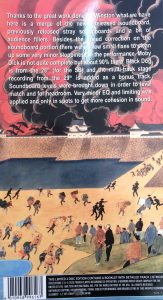













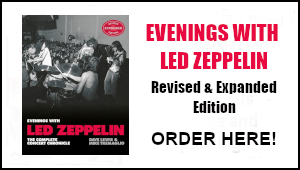
Leave your response!